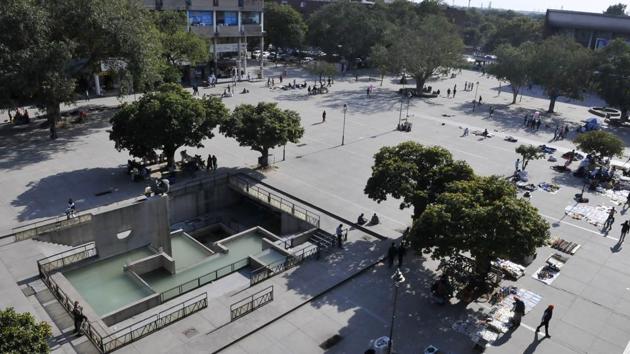HT Special | Reviving Chandigarh Sector 17: Heart is there, but where’s the beat?
Once upon a time, it used to throb with life. People from the city and nearby towns would wear their party best and descend on the Sector 17 plaza in the evenings. Many would sit around on the benches and even stairs as the musical fountain swished back and forth.
Once upon a time, it used to throb with life. People from the city and nearby towns would wear their party best and descend on the Sector 17 plaza in the evenings. Many would sit around on the benches and even stairs as the musical fountain swished back and forth.

Munching popcorn and relishing soft-serve ice creams, some would while away hours, strolling up and down the plaza. The square surrounded by rather forbidding concrete buildings would perennially wear a festive look, the weekends being simply maddening. With all big brands congregating to this Sector, it was truly a shoppers’ paradise. But all that was a few years ago.
Cut to the present. The plaza may not be totally deserted but the crowd is thin. The fountain still gurgles, but it looks old and forlorn with hardly any audience. The concrete buildings too appear grey and jaded. The shopkeepers look glum as there aren’t even enough window shoppers to keep them company. Only the number of pavement vendors has grown manifold. Then there are pesky salesmen chasing the visitors as they try to sell their rather shady looking eye-glasses and other gear.
THE UNIQUE PLAZA
Everyone agrees that Sector 17 has lost its sheen, and this is upsetting. After all, it isn’t just any other sector of the city. The diminishing crowd translates into financial losses. But more than that, there are sentiments attached to this place. Swiss-French architect Le Corbusier designed the sprawling piazza on the European pattern and intended it to be a pedestrian’s paradise. “The proportion of this square and the way it’s separated from the shops around it makes it unique,” says architect Namita Singh, who’s been involved in many projects with the UT administration.
APATHY TO BLAME
It’s a combination of market forces and administrative apathy that has brought the sector to this sorry state. No one could have done much about the factors like economic slowdown. But being a public property, the onus was on the administration to take initiatives to make it vibrant and keep the sector’s pulse going. There was a total failure on that count. The sector kept losing its vibe, and other places, especially the Elante mall, were quick to fill up that void. Locals and outsiders flock to the mall, like they used to religiously congregate in this sector. Elante is the new Sector 17.
The concern of residents is not that a new mall has emerged in a desolate corner that no one visited till some time back. The worry is how the sector lost out with bureaucrats and politicians only paying lip service to revive it all these years.

MARKET FORCES AT WORK
There are various factors that led to a decline in the footfall here. For one, the city’s only Inter-State Bus Stand was just a five-minute walk from the plaza. So, a trip to plaza was a must-do on the itinerary of all those travelling to the city. The bus stand has now been divided with a major chunk shifted to Sector 43.
The shifting of district courts to Sector 43 and many other government offices to Panchkula, Mohali and other places has also contributed to a drastic drop in the number of visitors.
Who can forget the cinema halls that used to attract massive crowds once upon a time. In days of state-ofthe-art multiplexes, the Neelam theatre wears a forsaken look. Jagat has converted into a multiplex but in absence of any shops it remains a renovated cinema hall. The KC Theatre with its unique dome shape was once a rage, but it’s been a work in progress for ages.
“The buying power of people is down regardless of the reasons,” says a Sector 17 showroom owner RP Malhotra. “At best people just come for window shopping when the weather is convenient.”
THE LONG ROUTE TO REJUVENATION
On paper, a lot is happening. The Smart City project envisages rejuvenation of the sector. “We will install energy-efficient lights, lay tiled pedestrian walkways, introduce underground smart parking, smart advertising panels, and cycle tracks besides landscaping the open spaces,” says an official. But does that sound attractive enough? Much more needs to be done.
“Two things are extremely vital for this sector to survive—get rid of vendors and chaos at the parking spaces so that people feel like coming back here,” says Jagdish Kalra, general secretary of Sector 17 Traders’ Association.
Not just that. There is also problem with the mindset of officers. There’s a feeling that the unimaginative babus have stuck to rules and refused to change with age.
“Every age has to have its own architecture,” says Namita Singh. “The officials have been too rigid about the framework of buildings. The architecture department can’t think beyond Corbusier or the line he drew.” She cites the case of Jagat and KC theaters for instance. They wanted to change from single screens to multiscreens and were told to fit into the same shape and area, she says.
Things have come to such a pass that even basics are missing. The other day governor VP Singh Badnore was shocked to see the filth and told his officers: “If you can’t clean it I’ll do it.”
Coming back to Corbusier, he had conceived the city’s master plan as analogous to human body. The city centre, Sector 17, was earmarked as the heart of its body with the capitol complex as its head. Well, the heart is there but the beat is missing.
(FIRST OF SEVEN-PART SERIES, TOMORROW: PARKING PROBLEM)





